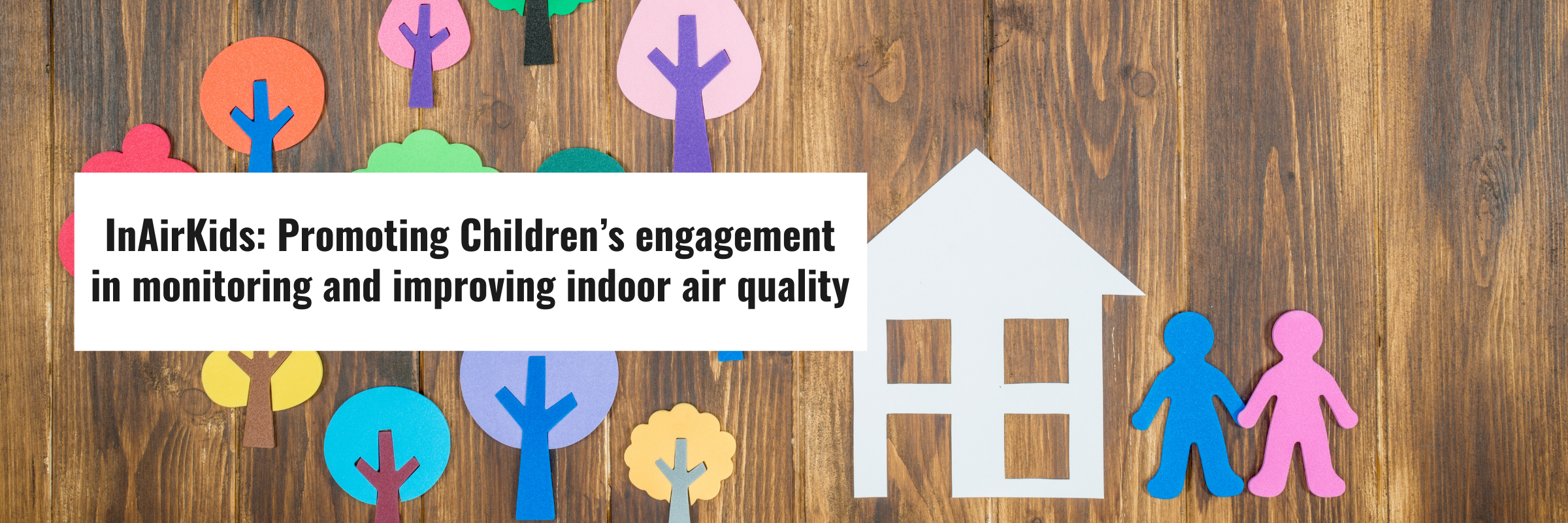
Summary
Indoor air quality (IAQ) is especially important for children because they are more susceptible to the deleterious impacts of poor air quality compared to adults. While devices to monitor IAQ are increasingly available, these are designed primarily for adults, and little attention has been paid to their potential use by children. The research aims to create a persuasive technology to empower children to better engage in monitoring and assessing IAQ, which will lead to improving IAQ.
Researchers and Partners
| Sunyoung Kim | Principal Investigator | Assistant Professor, Rutgers School of Communication and Information |
|---|---|---|
| Jen Senick | researcher | Executive Director, Rutgers Bloustein School of Urban Planning and Policy Development |
| Gedi Mainelis | researcher | Professor, Rutgers Department of Environmental Sciences |
| Catherine Hart | Community Partner | Deputy Executive Director, The Housing Authority of the City of Elizabeth (HACE) |
About this Project
Initial Approach
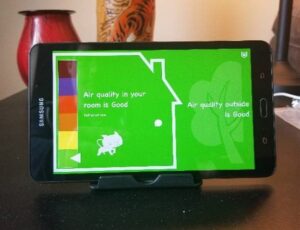
Traditionally, IAQ measurements have been conducted by experts using sophisticated and expensive equipment. Recently, there has been an increasing availability and capability of low-cost IAQ monitoring devices that offer great potential for effective monitoring and analysis of IAQ. Many of these tools are developed not only to measure IAQ but also to raise occupants’ awareness of indoor air pollution and promote healthier everyday practices as a form of persuasive technology. Using these tools, laypeople can monitor and evaluate IAQ and then take action to improve their indoor environmental conditions.
Most existing IAQ devices, however, are not designed specifically with children in mind, and their interfaces to visualize IAQ are not optimized for interaction with children. If the interface is designed without regard for users’ cognitive and other abilities, it can cause confusion and other deficits in how information is understood and acted upon. Because the needs, skills, and expectations of children differ drastically from those of adults, a technology designed for adult users can be difficult for children to use and embrace. This study investigates design considerations to best convey IAQ information to children, with the ultimate goal of creating an IAQ monitor optimized for children’s use in monitoring and improving IAQ.
The study consists of four phases
1. Literature review to elicit IAQ interventions that are actionable by children to improve IAQ
2. Participatory workshops to design a child-friendly user interface for IAQ visualization
3. System development
4. A field deployment study
Results and Findings
As of February 2020, we have completed three phases. The preliminary findings from each phase are as follows:
- Growing multi-disciplinary interest in reducing harmful exposures to air pollutants has led to an increasing number of studies about IAQ, which nevertheless lack a coherent framework posing a barrier to the rapid translation of research findings into action. We employed the social-ecological systems framework to organize identified IAQ variables and intervention strategies according to spatial scale and by individual and organizational agency. Based on the extensive literature review, we came up with the final list of IAQ intervention strategies and to highlight cost-effective strategies proven to reduce exposure to indoor air pollutants and improve IAQ. Tsoulou, I., Kim, S., Senick, J., Mainelis, G., “Residential Indoor Air Quality Interventions through a Social-Ecological Systems Lens: A Systematic Review” (under review).
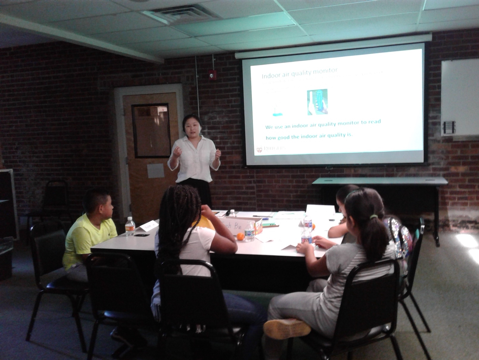
Children participate in a workshop and provide feedback about prototypes for IAQ visualization.
- We engaged children aged 6-8 in low-income households directly in the design of an IAQ visualization interface for children. In engaging children in participatory workshops, we found that they rely heavily on visual, olfactory, and thermal cues to perceive and assess IAQ. Reflecting on these findings and based on design principles for technology for children, we created and tested child-friendly interface prototypes for IAQ visualization. Based on children’s input, we designed a final set of visual interfaces that will be implemented in the IAQ monitor. Kim, S., Li, M., Senick, J., & Mainelis, G. (2020, June). Designing to engage children in monitoring indoor air quality: a participatory approach. In Proceedings of the Interaction Design and Children Conference (pp. 323-334).
- Based on the findings from the first two stages, we designed and developed a child-friendly interface to visualize IAQ and provide actionable interventions to improve IAQ as a mobile app that runs on a table PC.
A set of final prototypes for graphical visualization of IAQ for children
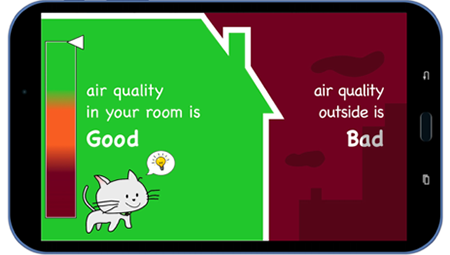
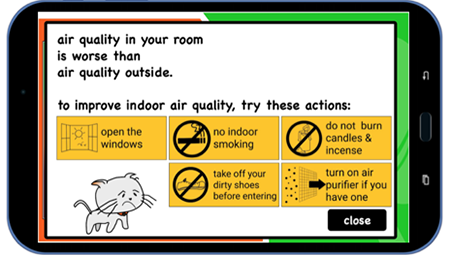
Evolution and Change
Initially, this project has aimed to explore an IAQ solution for children in low-income households who are at particular risk of indoor air pollution; Households of low socio-economic status generally experience poorer indoor air quality, but they often lack access to information about health problems associated with poor IAQ and the means to address them. Our hypothesis was that a persuasive technology could motivate children in low-income families to better engage in monitoring and assessing IAQ, which eventually will lead to improving IAQ. We completed participatory design workshops with children in low-income households to create a child-friendly visualization for IAQ. Then, we developed a working system for its longitudinal field deployment study.
Then, the COVID-19 pandemic made it extremely difficult to recruit participants; families in low-income households who are the most vulnerable were hesitant to participate in the study since it requires a researcher’s visit to a house for system installation and the community partner could not help with recruitment because they closed their office and minimized their physical interaction with residents. After having difficulty in participant recruitment for several months, we switched the target population from children in low-income families to any children. While low-income families are especially vulnerable to poor IAQ, the COVID-19 pandemic increased the time people stay indoors, which increased the overall awareness and consciousness about IAQ.
Next Steps
Currently we are conducting a 4-month field deployment study as a final stage of the project. The expected timeline for completing the study is mid-March. Once the deployment study completes, we will write a final report and finalize the project.
